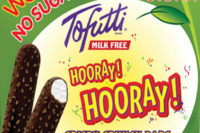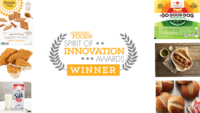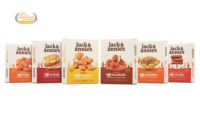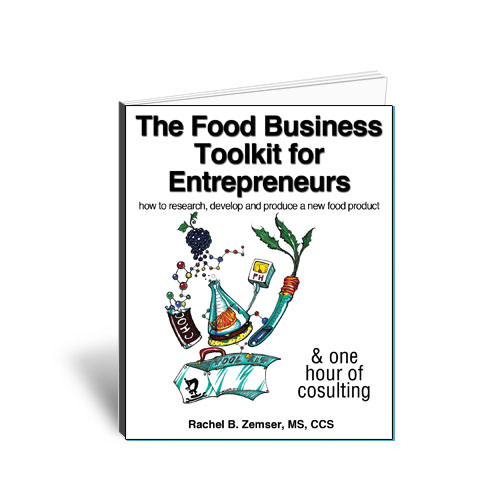SPIRIT OF INNOVATION AWARDS | 2012 FOODSERVICE WINNERS
2012 Innovation Awards - Food Service




1st Place – Foodservice:
Sandridge Food Corp. / Fresh Grain Salads
Sometimes, a team has to think outside the box. Then again, there are times when a customer might ask a company to literally think outside its plant’s capabilities. Such was the case for Sandridge Food Corp., a refrigerated deli salads processor.
Lynnea Jodway, Sandridge marketing coordinator, explains, “One of our customers approached us last fall for a new, innovative grain salad. Grain salads are in demand for many consumers, including the healthcare segment, colleges and universities, as well as many restaurants and delis. These salads answer consumer demand for better-for-you, nutritional items that are full flavor.”
“Also, many of the grain salads embody an ethnic flavor profile to meet consumers’ desire for global cuisine,” she continues. “They are better-for-you, fresh, refrigerated salads with many desirable attributes, such as gluten-free, vegan, preservative-free, dairy-free, 0g trans fat and high-fiber. They provide convenience, versatility, robust flavors and endless options for restaurants and delis to create signature dishes.”
But, there was just one hang-up. Grains were foreign to Sandridge Food’s traditional, refrigerated prepared product line—everything from the core ingredients used to make the salads, cooking methods required to get the right texture, and the customers who are interested in such a product. For that matter, the company had to discover a solution for preserving the salads for ultimate freshness without the use of preservatives or freezing.
In part, operations had a role in the solution. Sandridge spent millions to buy and install a high-pressure pasteurization system (HPP), a cold-water process that exposes product to pressure that destroys bacteria but does not affect particulate taste, texture or color.
Meanwhile, Sandridge chefs and product developers came up with nine new grain salads:
Apple Cranberry Couscous — Tri-colored Israeli couscous tossed with sweetened dried cranberries and parsley in a light apple-agave vinaigrette.
Apple Pecan Couscous — Tri-colored Israeli couscous, wheat berries and split peas, tossed with bell peppers and green onions in a light apple-honey vinaigrette.
Curried Chickpea & Couscous — Fiber-rich garbanzo beans, Indian spices, Israeli couscous, sweet golden raisins and sea salt, lightly dressed in curry vinaigrette.
Ginger & Fruit Barley Salad — Barley, crisp peppers, kale, ginger and sea salt lightly dressed in a sesame and citrus vinaigrette.
Mediterranean Couscous — Couscous tossed with fresh ripe tomatoes, zucchini, green bell peppers, red onions, parsley and sea salt in a light citrus and lemon oil vinaigrette.
Greek Orzo Base — Orzo, roasted red peppers, and tomatoes and feta cheese tossed in a lemon garlic vinaigrette.
Quinoa Salad Base — Protein packed quinoa, green lentils, brown lentils and split peas tossed with fresh parsley, finished in a lemon vinaigrette.
Tex Mex Quinoa Base – Protein-packed quinoa, pinto beans and sweet corn with cilantro, garlic and chipotle seasonings, lightly dressed in a house-made lime vinaigrette.
Wheatberry & Fruit Base — Bulgur wheat and wheat berries tossed with sweetened, dried cranberries, bell peppers, currants and mangos, finished with a light vinaigrette and pure maple syrup.
Sandridge chefs, led by Dan Zakri, manager of new product development, and Mike Matranga, new product development chef, tested a variety of ingredients and combinations. They ultimately created more than 25 new salads and then narrowed the range down to the line’s final nine, which are minimally dressed and not pH-controlled. Development began in fall 2011, and the products were launched during this past spring and summer.
Despite that quick turn-around time, the group had to resolve a number of key challenges along the way.
“…[T]he small particulate size, plus lower levels of dressing, packaging the salads properly to preserve freshness, appearance, taste and quality—it all required creative thinking by our production department,” says Jodway. “They met the challenge, though, and learned how to package the products successfully with the utmost food safety.”
2nd Place – Foodservice:
Gagne Foods / Double Chocolate Biscuits
Peanut butter and jelly. Chocolate and peanut butter. Cookies and cream. Some great tastes just seem like they were meant to be together, and that was the logic behind Gagne Foods’ new Double Chocolate Biscuits.
The term “biscuit” here is not, by any stretch, the British definition, more commonly known as “cookies” on American shores. No, the Gagne Foods’ product is definitely a “biscuit” more in keeping with the flakey pastry traditionally found accompanying breakfasts. It also features chocolate, which translates virtually the same in most every language.
As owner Michael Gagne notes, “The dough is sheeted, much like puff pastry, then cut and frozen. The result is a light and fluffy biscuit, tender and truly chocolaty.”
The chocolate, itself, is fair trade, reflecting consumer interest in more socially conscious food, and cocoa powder and semi-sweet chocolate chips were added to the company’s award-winning cream cheese recipe (a formulation incorporating cream cheese and butter, instead of shortening).
Gagne, a chef with 40 years experience, notes, “The flavor is not too sweet, allowing this product to be interpreted for menu applications throughout the day.”
Gagne, himself, heads up the company’s R&D team and says he is accustomed to using very high-quality chocolate, but he wanted to “go a step further” and use high-quality, fair trade chocolate.
“However, we think it’s worth it,” he continues. “We also were challenged by the chocolate chunks in our dough; as it moves down our production line, they aren’t malleable, so we had some challenges getting them small enough to fit through our extruder but large enough to leave pools of melting chocolate throughout the product when eating it.”
3rd Place – Foodservice:
King & Prince Seafood / Sushi Bob
King & Prince Seafood knows college and university foodservice operators face a challenging, diverse and demanding consumer base.
This is a group unlike college students of the past, for whom cold pizza comprised almost the entire food pyramid. No. Today’s college crowd is accustomed to a range of selections; entrees with authentic ethnic flavors; and an assortment of healthy meal items.
Unfortunately, these more complicated dishes can pose new, labor-related problems for university operators. In collaboration with a supplier, King & Prince devised an option for operators looking to add sushi rolls to their lines: Sushi Bob. The frozen Sushi Bob kit allows operators to use available workers to prepare fresh sushi. Meanwhile, the kit helps deliver more profits than commissary-sourced sushi, says Susan Gurkin, King & Prince’s director of innovation.
It’s easy for foodservice staffers to quickly learn to use the Sushi Bob kit. Once the product thaws and is ready, each sushi roll takes 1-2 minutes to roll, cut and serve. All sushi then is made fresh that same day or fresh to order, using fresh vegetables and other ingredients the operator can source from current suppliers, Gurkin relates.
In addition to being fresh and convenient, the product also has nutritional appeal. Seafood is a healthy source of protein and omega-3 fatty acids, and the nori sheet is said to be an excellent source of antioxidants and other trace minerals. Each kit will make exactly 32 rolls of sushi, and a total of five different sushi kits are available: Smoked Salmon, Ground Tuna, Tempura Shrimp, Imitation Crab Leg and Lobster Sensations.
Gurkin says King & Prince relied on its marketing, quality assurance, logistics, sales, procurement and operations departments—as well as several valued suppliers—to develop Sushi Bob. She describes the project as “quite possibly the most collaborative relationship King & Prince has developed with any supplier. In fact, representatives from one certain supplier were involved in every step of the process…This is truly a unique partnership and one we hope to replicate with other suppliers in the future.”
Looking for a reprint of this article?
From high-res PDFs to custom plaques, order your copy today!









